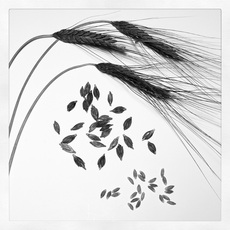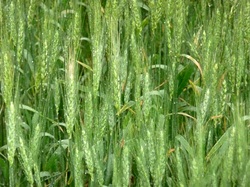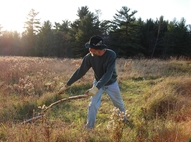 Black Winter Emmer Black Winter Emmer Ever wonder how to get the hulls off of your homegrown Einkorn and Emmer, so you can eat them? I have heard of this solution, but I haven't tried it yet. Here is a video on YouTube of a simple way to do it. At 1:00, notice that a thick, flat rubber ring has been mounted over the main steel plate of a Corona or Porkert grain mill. The other steel plate is left bare. The grain heads are cut off the stems, and then run through the grinder. The plates need to be adjusted for firm, but not crushing pressure. As you turn the crank, the metal teeth of the steel plate, rubs the hulled grain against the rubber plate, and the friction rubs the hulls apart. Then the grain is separated from the chaff, by winnowing it in the wind. On an even smaller scale, you can use the ancient method of toasting the hulls in a frying pan until very dry, then crushing the hulls with a mortar and pestle, and then winnow in the wind to separate the grain from the chaff. - Botan Anderson
2 Comments
A History of Harvesting Grains, from the Scythe to Gigantic Modern CombinesWhile it's amazing what a $500,000 combine can do, how does a small acreage farmer homesteader grow and harvest their own grain? Even small walk-behind combines cost a fortune. From 4:40 to 14:14, the above documentary shows how grains used to be harvested by hand, with a scythe and a flail. There is some good historical footage in this video. While the modern reenactment was done when the grain was at peak ripeness, the narrator explains at 6:55 that grains were traditionally harvested with a scythe before peak ripeness, so fewer grains would get knocked loose while harvesting. Then the grain was tied into sheaves and stacked in the field, in shocks, to finish ripening. Modern combines harvest wheat at complete ripeness.
From my limited experience with harvesting grains, I would say that oats have got to be one of the easiest grains to mow with a scythe, but one of the hardest to mow neatly. It practically jumps out of the way of the scythe blade, but the grain heads fall to the right, or every which way, unless you use a grain cradle. "Where can I get a grain cradle?", you ask. If I could get them, believe me, I would carry them. Unfortunately, I don't know of anybody that still manufactures a grain-cradle. It's on my list of products to develop for 1SR, but until then you will have to make your own. Or.... you could try this simple technique. In the video below, these people are implementing a brilliant idea that I have not seen, or heard of before. An assistant to the scyther, holds a light pole against the standing grain, for the scyther's next stroke, which keeps it from falling over, and apparently has the effect of guiding the stalks to move over to the left, just like it would with a grain cradle! I can't wait to try this myself! If any of you get to it before I do, let me know how it works out. I just found a great video on YouTube of a traditional wheat harvest demonstration in Germany. It shows the sophisticated German bow cradle in use, and how the scythe is swung into the standing grain. The cradle presses the cut grain stems up against the standing stems, to compresses the fallen grain stems into alignment, to make it easier to gather them into sheaves. See the link below. For more info, also check out my grain Harvesting workshop page. Harvesting Grains
"From Farm to Table" A documentary posted on YouTube by Lucio Hernández, that shows the growing and harvesting of grains in the Brena Alta region of the island of La Palma, of the Canary Islands. It shows the cycle of plowing the field, seeding by hand broadcasting, handweeding of the grain field, and harvesting with sickles. Also threshing with oxen drawn sleds. Anybody that reads this post that speaks Spanish, please add any useful info in the comments section below. Here's a gem. The wheat harvest starts 3:00 minutes in. Good video quality. Watch it full screen at https://www.youtube.com/watch?v=hb4QYOHV8i8&feature=endscreen&NR=1 The winter grains are thigh high already. Time to finally figure out a homemade grain cradle, of some sort. Here are a couple of ideas, from wildseed01 on YouTube. Thanks Wildseed01 for sharing this good info! Below is a simple bow cradle (boyle) with a pricker. See 0:54 for still picture. This one can be completely homemade with some green willow, a thin angle iron, and some good twine. |
Botan AndersonArchives
March 2023
Categories
All
|





 RSS Feed
RSS Feed